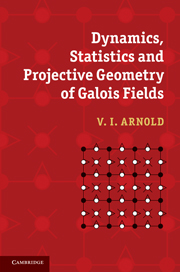Book contents
- Frontmatter
- Contents
- Preface
- 1 What is a Galois field?
- 2 The organisation and tabulation of Galois fields
- 3 Chaos and randomness in Galois field tables
- 4 Equipartition of geometric progressions along a finite one-dimensional torus
- 5 Adiabatic study of the distribution of geometric progressions of residues
- 6 Projective structures generated by a Galois field
- 7 Projective structures: example calculations
- 8 Cubic field tables
- Index
4 - Equipartition of geometric progressions along a finite one-dimensional torus
Published online by Cambridge University Press: 01 March 2011
- Frontmatter
- Contents
- Preface
- 1 What is a Galois field?
- 2 The organisation and tabulation of Galois fields
- 3 Chaos and randomness in Galois field tables
- 4 Equipartition of geometric progressions along a finite one-dimensional torus
- 5 Adiabatic study of the distribution of geometric progressions of residues
- 6 Projective structures generated by a Galois field
- 7 Projective structures: example calculations
- 8 Cubic field tables
- Index
Summary
Two very different ways of formulating a problem exist: the abstract way, characteristic of Bourbaki, consists of the most general formulation, thus leaving no possibility for further generalisations; and the opposite concrete way is to choose a simple case that cannot be simplified further yet preserves some content of the problem.
I tried in Chapter 3 to formulate the field table randomness conjectures in the abstract form.
Let us consider now the concrete form of the first of these conjectures concerning the equidistribution of progressions in fields of pn elements. To do it, we restrict ourselves to the simplest field ℝp, which consists of the p residues after division by a prime number p: that is, consider the simplest case n = 1 of the general theory of Chapter 3.
To simplify the formulas, we shall suppose the prime p to be odd and we shall choose as the domain G of Chapter 3 the first half of the non-zero elements of the field, that is, {c : 1 ≤ c ≤ (p − 1)/2}, |G| = (p − 1)/2.
As the segment of the geometric progression of residues we consider its first m = (p − 3)/2 terms, {Ak : 1 ≤ k ≤ m}.
This strange choice for “half” of the progression (ϑ ≈ 1/2) is explained by the statement of the little Fermat theorem: Ap−1 = 1, making Ak = −1 for k = (p − 1)/2.
- Type
- Chapter
- Information
- Publisher: Cambridge University PressPrint publication year: 2010



